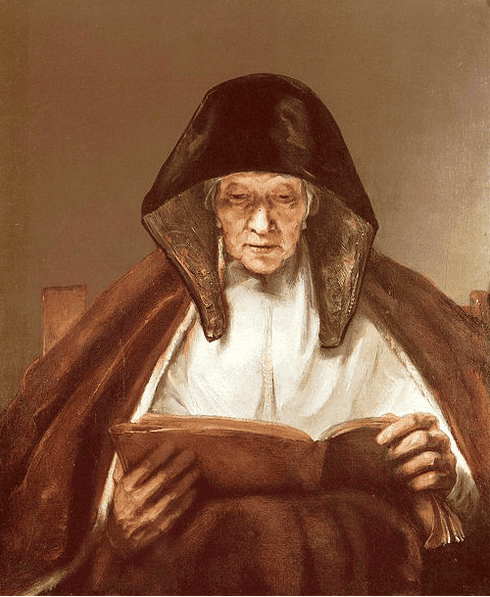Stella's Biography
May I [Rudd] present to you my old and dear friend Stella, 1926-2016, whose love for non-routine mathematics problems, not to mention her large collection of them, prompted me to begin to develop the organized library known as Stella's Stunners more than 30 years ago.
Many people have inquired about Stella herself, so I present here a short biography.
Stella, as I knew her for many years, is the informal name of Ecaterina Elizabeth van Heemsvloet tot Schattenberg. (Ay-cat-er-i'na Ay-liz'-a-bet fahn Hayms'-flute toat Skah'-ten-bairg.) Stella was a Dutch baroness, born in Amsterdam in 1926. She studied the piano from an early age, showing much talent. She was 14 when the war came to Holland, and she spent five difficult and dangerous years as a message courier in the Dutch resistance, while still keeping up her piano studies. In her university years after the war she discovered a love for mathematics puzzle problems, and would carry a problem around with her in her purse until she had solved it.
In the early 1950's she went to Paris to study piano and music theory with the formidable Nadia Boulanger. She studied there for four years and grew enormously as a pianist and overall musician.
Unfortunately for me and for us, Stella herself threw a curtain over her life in the later years of that decade. I was never been able to draw her out to talk about those years. What we do know is that by 1961 she had traveled to Venice, where she studied the complicated geometric patterns in the marble floors of the great palazzi and churches. Late one night, returning from a concert, she had the misfortune of tripping and falling into the Grand Canal. She was rescued by the handsome, muscular, and aristocratic Graziano Pelligrini, who had seen the accident from the window of his palazzo. He ran out, stripped, jumped into the canal, and saved her. Shortly thereafter she married him. For the next thirty years they divided their time between his Venetian palazzo and her elegant flat in the old southern section (Oud Zoud) of Amsterdam, where her matched pair of Steinway grand pianos was kept. She practiced daily, and loved to play four-hand piano with her husband (although, she said, he needed to practice more).
It was after her marriage that Stella resurrected her knowledge of elementary mathematics, working her way up through the usual subjects to the level of differential calculus. She thus was able to expand the scope of her problem-solving considerably, and her collection of non-routine problems grew steadily.
I first met Baroness Stella and her husband in 1965, at a party given by close Dutch friends of ours. I found her charming and, I must confess, somewhat formidable. As an example, I can recount a moment during the party when I was refilling the guests' wine glasses. When I came to Stella, she smiled graciously and said, "No thank you, I only like it out of the top half of the bottle."
When she learned that I was a mathematics teacher who liked non-routine problems, a bond was immediately established, and she and I began to trade problems by mail, each trying to stump the other. She had plenty of material to draw on, having added to her problem collection from time to time over the years. Whether it was performing Brahms or solving math problems or anything else, she maintained intense concentration on whatever she was doing. Even when she was simply peeling a carrot, one felt that the whole world fell away except for Stella, the carrot, and the knife.
In the early 1980's, Stella began asking me pointed questions about what kind of mathematical work I was giving my students to do at Oberlin High School. She was not satisfied with my answers. When she offered to help me start a collection of more challenging problems for me to have my students to do, I could not resist. She was hired as an informal overseas consultant to the mathematics department. She developed and gave me the Stella Decimal System, which has proved invaluable in managing the large number of problems that have found their way into the library.
Stella became a widow her 80's, when her beloved husband Graziano somewhat ironically fell into a canal in Amsterdam and drowned. In the informal world of today, she maintained her elegance and formality – it was fascinating, for example, to watch her eat a piece of buttered toast with a knife and fork. She maintained her mental faculties by solving one or two mathematics problems daily, right up to the end of her life. She found geometric proofs particularly attractive, and found those posed on British examinations particularly stimulating. She jogged three times a week, with her young piano student and all-around helper Jasper accompanying her. Stella began studying Spanish, adding it to her fluent French, English, Italian, and of course Dutch. She told me that she planned to visit Barcelona soon, but alas, that never happened – she died in her sleep shortly after her 90th birthday.
Stella, love, may your problems inspire students forever.
I like to think that this painting by Rembrandt, Old Woman Reading, 1655, could be a painting of one of Stella's ancestors. There's a definite resemblance.
